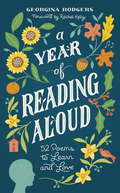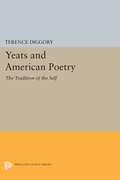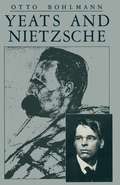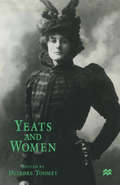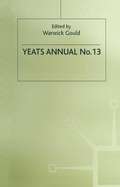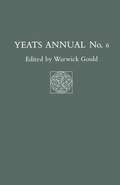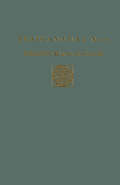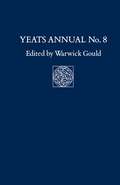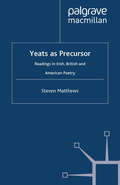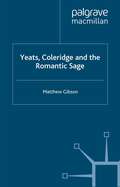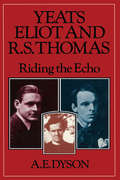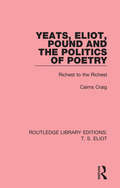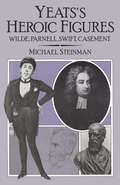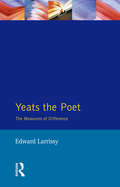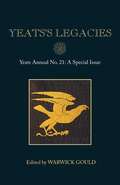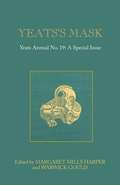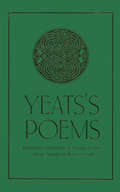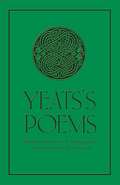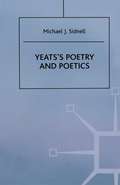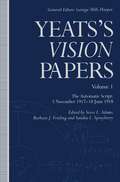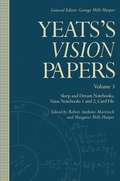- Table View
- List View
A Year of Reading Aloud: 52 poems to learn and love
by Georgina Rodgers'In a world in which we tend to look to what's new, to cutting-edge science and to medical breakthroughs for hope in better health, there's something marvellous in the realisation that one of the most beautiful and longest-lasting cures has been here all along - on the internet, on our bookshelves, under our noses. Words - down the centuries, over the ether, across the miles - have power to steady us, to make us feel better.' the ObserverThe ancient tradition of learning and reciting poetry is renowned for its wellbeing benefits - from strengthening the mind and boosting creativity to improving memory. The practice is as valuable as ever in our busy modern day lives, allowing us to focus on the rhythm of the present moment, slow down and switch off.A Year of Reading Aloud celebrates the power of spoken word with a poem to learn and love for each week of the year. Drawing both on familiar favourites and new voices, from Sylvia Plath and Maya Angelou to Instapoets Nikita Gill and Yrsa Daley-Ward - this is a book that will capture your imagination through verse and help you fall back in love with this beautiful art form. Includes a foreword by Rachel Kelly, bestselling author of 52 Small Steps to Happiness and Black Rainbow.
Yeats and American Poetry: The Tradition of the Self
by Terence DiggoryThis work is designed to show a double influence: first, that of American poets, especially Whitman, on W. B. Yeats, and, second, of Yeats on a wide range of American poets who began their careers during the first decades of the century.Originally published in 1983.The Princeton Legacy Library uses the latest print-on-demand technology to again make available previously out-of-print books from the distinguished backlist of Princeton University Press. These editions preserve the original texts of these important books while presenting them in durable paperback and hardcover editions. The goal of the Princeton Legacy Library is to vastly increase access to the rich scholarly heritage found in the thousands of books published by Princeton University Press since its founding in 1905.
Yeats and Nietzsche: An Exploration of Major Nietzschean Echoes in the Writings of William Butler Yeats
by Otto BohlmannYeats and Women
by Deirdre ToomeyYeats and Women , published originally in the Yeats Annuals series, collects eight essays on Yeats's relationships with women, two collections of letters to him and his broadcast, 'Poems about Women'. The essays cover sexuality and its dynamic in Yeats's writing: his attitude to feminism and to the 'feminist occult'; his relationships with Maud Gonne, Dorothea Hunter, Olivia Shakespear, Florence Farr, Iseult Gonne and George Yeats. Yeats's relationship with Lady Gregory and her co-authorship of Cathleen ni Houlihan is analysed. The collection includes 12 plates.
Yeats Annual No. 13 (Yeats Annual)
by Warwick GouldYeats Annual is the leading international research-level journal devoted to the greatest twentieth-century poet in the English language. In this number there are new essays on Yeats's theatre by leading scholars such as Richard Allen Cave, Gregory N. Eaves and Masaru Sekine, while scholars from nine countries including Peter L. Caracciolo and Paul Edwards, Maneck H. Daruwala, William F. Halloran, Elisabeth Heine and Colleen MacKenna address such matters as 'Yeats and Maud Gonne: Marriage and the Astrological Record, 1908-9', Yeats's relations with Fiona Macleod and with Wyndham Lewis, the Ghost of Wordsworth, Philip Larkin and Seamus Heaney. There are new essays on A Vision , shorter bibliographical notes and reviews of ten new studies.
Yeats Annual No 6 (Yeats Annual)
by Warwick GouldThis research-level publication for current thought and documentation upon the life and work of Yeats, focuses on Yeats at work on various manuscripts and on his tours of America. Two of his poems are published from manuscript for the first time.
Yeats Annual No 7: including Essays in Memory of Richard Ellmann (Yeats Annual)
by Warwick GouldThe essays in Yeats Annual No 7 are dedicated to the memory of Richard Ellmann, one of the great pioneer critics of W.B.Yeats. They have been contributed by distinguished colleagues and friends of Richard Ellmann, chosen on his advice. The volume also contains much new material by Yeats himself - a new and virtually complete early draft of his novel The Speckled Bird, here entitled 'The Lilies of the Lord' and two new poems from The Flame of the Spirit manuscript book, given to Maud Gonne in 1981.
Yeats Annual No. 8 (Yeats Annual)
by Warwick GouldYeats Annual No.8 has two distinct themes: Yeats's poetic technique and his aims for an Irish Theatre. Essays from Helen Vendler, Richard Taylor, Timothy Armstrong and Wayne Chapman place the poetry under close scrutiny and offer challenging new studies. Yeats himself writes the remaining essays, including the long-awaited first publication of his Wildean dialogue and an uncollected address on the Irish National Theatre delivered in 1934. Richard Londraville edits four of Yeats's lectures given in England and America in 1902-4.
Yeats as Precursor: Readings in Irish, British and American Poetry
by S. MatthewsAs both a late Romantic and a modern, W.B. Yeats has proved to be perhaps the most influential poet of the early twentieth-century. In this original study Steven Matthews traces, through close readings of significant poems, the flow of Yeatsian influence across time and cultural space. By engaging with the formalist criticism of Harold Bloom and Paul de Man in their dialogues with Jacques Derrida, he also considers Yeats's significance as the founding presence within the major poetry criticism of the century.
Yeats, Coleridge and the Romantic Sage
by M. GibsonThis work explores an aspect of Yeats's writing largely ignored until now: namely, his wide-ranging absorption in S.T. Coleridge. Gibson explores the consistent and densely woven allusions to Coleridge in Yeats's prose and poetry, often in conjunction with other Romantic figures, arguing that the earlier poet provided him with both a model of philosopher - 'the sage' - and an interpretation of metaphysical ideas which were to have a resounding effect on his later poetry, and upon his rewriting of A Vision.
Yeats, Eliot, Pound and the Politics of Poetry: Richest to the Richest (Routledge Library Editions: T. S. Eliot)
by Cairns Prof. CraigIt has long been recognised that there is an apparently paradoxical relationship between the revolutionary poetic style developed by Yeats, Eliot and Pound in the period during and after the First World War, and the reactionary politics with which they were associated in the 1920s and 1930s. Concentrating on their writings in the period up to the 1930s, this study, first published in 1982, helps to resolve the paradox and also provides a much needed reappraisal of the factors influencing their poetic and political development. The work of these poets has usually been seen as deriving from the tradition of continental symbolist poetics. Yeats, Eliot, Pound and the Politics of Poetry will be of interest to students of literature.
Yeats, Eliot, Pound and the Politics of Poetry: Richest to the Richest (Routledge Library Editions: T. S. Eliot #2)
by Cairns Prof. CraigIt has long been recognised that there is an apparently paradoxical relationship between the revolutionary poetic style developed by Yeats, Eliot and Pound in the period during and after the First World War, and the reactionary politics with which they were associated in the 1920s and 1930s. Concentrating on their writings in the period up to the 1930s, this study, first published in 1982, helps to resolve the paradox and also provides a much needed reappraisal of the factors influencing their poetic and political development. The work of these poets has usually been seen as deriving from the tradition of continental symbolist poetics. Yeats, Eliot, Pound and the Politics of Poetry will be of interest to students of literature.
Yeats The Poet: The Measures of Difference
by Edward LarrissyThis work addresses Yeats's "antinomies", seeing their origin and structure in his divided Anglo-Irish inheritance and examining the notion of measure. It then explores how this relates to freemasonry, Celticism and Orientalism and looks at the Blakean esoteric language of contrariety and outline which provided Yeats with the vocabulary of self-understanding.
Yeats The Poet: The Measures of Difference
by Edward LarrissyThis work addresses Yeats's "antinomies", seeing their origin and structure in his divided Anglo-Irish inheritance and examining the notion of measure. It then explores how this relates to freemasonry, Celticism and Orientalism and looks at the Blakean esoteric language of contrariety and outline which provided Yeats with the vocabulary of self-understanding.
Yeats's Legacies: Yeats Annual No. 21 (Yeats Annual Ser. #Vol. 21)
by Warwick GouldThe two great Yeats Family Sales of 2017 and the legacy of the Yeats family’s 80-year tradition of generosity to Ireland’s great cultural institutions provide the kaleidoscope through which these advanced research essays find their theme. Hannah Sullivan’s brilliant history of Yeats’s versecraft challenges Poundian definitions of Modernism; Denis Donoghue offers unique family memories of 1916 whilst tracing the political significance of the Easter Rising; Anita Feldman addresses Yeats’s responses to the Rising’s appropriation of his symbols and myths, the daring artistry of his ritual drama developed from Noh, his poetry of personal utterance, and his vision of art as a body reborn rather than a treasure preserved amid the testing of the illusions that hold civilizations together in ensuing wars. Warwick Gould looks at Yeats as founding Senator in the new Free State, and his valiant struggle against the literary censorship law of 1929 (with its present-day legacy of Irish anti-blasphemy law still presenting a constitutional challenge). Drawing on Gregory Estate documents, James Pethica looks at the evictions which preceded Yeats’s purchase of Thoor Ballylee in Galway; Lauren Arrington looks back at Yeats, Ezra Pound, and the Ghosts of The Winding Stair (1929) in Rapallo. Having co-edited both versions of A Vision, Catherine Paul offers some profound reflections on ‘Yeats and Belief’. Grevel Lindop provides a pioneering view of Yeats’s impact on English mystical verse and on Charles Williams who, while at Oxford University Press, helped publish the Oxford Book of Modern Verse. Stanley van der Ziel looks at the presence of Shakespeare in Yeats’s Purgatory. William H. O’Donnell examines the vexed textual legacy of his late work, On the Boiler while Gould considers the challenge Yeats’s intentionalism posed for once-fashionable post-structuralist editorial theory. John Kelly recovers a startling autobiographical short story by Maud Gonne. While nine works of current biographical, textual and literary scholarship are reviewed, Maud Gonne is the focus of debate for two reviewers, as are Eva Gore-Booth, Constance and Casimir Markievicz, Rudyard Kipling, David Jones, T. S. Eliot and his presence on the radio.
Yeats's Legacies: Yeats Annual No. 21 (Yeats Annual #21)
by Warwick GouldThe two great Yeats Family Sales of 2017 and the legacy of the Yeats family’s 80-year tradition of generosity to Ireland’s great cultural institutions provide the kaleidoscope through which these advanced research essays find their theme. Hannah Sullivan’s brilliant history of Yeats’s versecraft challenges Poundian definitions of Modernism; Denis Donoghue offers unique family memories of 1916 whilst tracing the political significance of the Easter Rising; Anita Feldman addresses Yeats’s responses to the Rising’s appropriation of his symbols and myths, the daring artistry of his ritual drama developed from Noh, his poetry of personal utterance, and his vision of art as a body reborn rather than a treasure preserved amid the testing of the illusions that hold civilizations together in ensuing wars. Warwick Gould looks at Yeats as founding Senator in the new Free State, and his valiant struggle against the literary censorship law of 1929 (with its present-day legacy of Irish anti-blasphemy law still presenting a constitutional challenge). Drawing on Gregory Estate documents, James Pethica looks at the evictions which preceded Yeats’s purchase of Thoor Ballylee in Galway; Lauren Arrington looks back at Yeats, Ezra Pound, and the Ghosts of The Winding Stair (1929) in Rapallo. Having co-edited both versions of A Vision, Catherine Paul offers some profound reflections on ‘Yeats and Belief’. Grevel Lindop provides a pioneering view of Yeats’s impact on English mystical verse and on Charles Williams who, while at Oxford University Press, helped publish the Oxford Book of Modern Verse. Stanley van der Ziel looks at the presence of Shakespeare in Yeats’s Purgatory. William H. O’Donnell examines the vexed textual legacy of his late work, On the Boiler while Gould considers the challenge Yeats’s intentionalism posed for once-fashionable post-structuralist editorial theory. John Kelly recovers a startling autobiographical short story by Maud Gonne. While nine works of current biographical, textual and literary scholarship are reviewed, Maud Gonne is the focus of debate for two reviewers, as are Eva Gore-Booth, Constance and Casimir Markievicz, Rudyard Kipling, David Jones, T. S. Eliot and his presence on the radio.
Yeats’s Legacies: Yeats Annual No. 21 (PDF)
by Warwick GouldThe two great Yeats Family Sales of 2017 and the legacy of the Yeats family’s 80-year tradition of generosity to Ireland’s great cultural institutions provide the kaleidoscope through which these advanced research essays find their theme. Hannah Sullivan’s brilliant history of Yeats’s versecraft challenges Poundian definitions of Modernism; Denis Donoghue offers unique family memories of 1916 whilst tracing the political significance of the Easter Rising; Anita Feldman addresses Yeats’s responses to the Rising’s appropriation of his symbols and myths, the daring artistry of his ritual drama developed from Noh, his poetry of personal utterance, and his vision of art as a body reborn rather than a treasure preserved amid the testing of the illusions that hold civilizations together in ensuing wars. Warwick Gould looks at Yeats as founding Senator in the new Free State, and his valiant struggle against the literary censorship law of 1929 (with its present-day legacy of Irish anti-blasphemy law still presenting a constitutional challenge). Drawing on Gregory Estate documents, James Pethica looks at the evictions which preceded Yeats’s purchase of Thoor Ballylee in Galway; Lauren Arrington looks back at Yeats, Ezra Pound, and the Ghosts of The Winding Stair (1929) in Rapallo. Having co-edited both versions of A Vision, Catherine Paul offers some profound reflections on ‘Yeats and Belief’. Grevel Lindop provides a pioneering view of Yeats’s impact on English mystical verse and on Charles Williams who, while at Oxford University Press, helped publish the Oxford Book of Modern Verse. Stanley van der Ziel looks at the presence of Shakespeare in Yeats’s Purgatory. William H. O’Donnell examines the vexed textual legacy of his late work, On the Boiler while Gould considers the challenge Yeats’s intentionalism posed for once-fashionable post-structuralist editorial theory. John Kelly recovers a startling autobiographical short story by Maud Gonne. While nine works of current biographical, textual and literary scholarship are reviewed, Maud Gonne is the focus of debate for two reviewers, as are Eva Gore-Booth, Constance and Casimir Markievicz, Rudyard Kipling, David Jones, T. S. Eliot and his presence on the radio.
Yeats’s Mask: Yeats Annual No. 19 (PDF)
by Margaret Mills Harper Warwick GouldYeats's Mask, Yeats Annual No. 19 is a special issue in this renowned research-level series. Fashionable in the age of Wilde, the Mask changes shape until it emerges as Mask in the system of A Vision. Chronologically tracing the concept through Yeats's plays and those poems written as 'texts for exposition' of his occult thought which flowers in A Vision itself (1925 and 1937), the volume also spotlights 'The Mask before The Mask' numerous plays including Cathleen Ni-Houlihan, The King's Threshold, Calvary, The Words upon the Window-pane, A Full Moon in March and The Death of Cuchulain. There are excurses into studies of Yeats's friendship with the Oxford don and cleric, William Force Stead, his radio broadcasts, the Chinese contexts for his writing of 'Lapis Lazuli'. His self-renewal after The Oxford Book of Modern Verse, and the key occult epistolary exchange 'Leo Africanus', edited from MSS by Steve L. Adams and George Mills Harper, is republished from the elusive Yeats Annual No. 1 (1982). The essays are by David Bradshaw, Michael Cade-Stewart, Aisling Carlin, Warwick Gould, Margaret Mills Harper, Pierre Longuenesse, Jerusha McCormack, Neil Mann, Emilie Morin, Elizabeth Müller and Alexandra Poulain, with shorter notes by Philip Bishop and Colin Smythe considering Yeats's quatrain upon remaking himself and the pirate editions of The Land of Heart's Desire. Ten reviews focus on various volumes of the Cornell Yeats MSS Series, his correspondence with George Yeats, and numerous critical studies. Yeats Annual is published by Open Book Publishers in association with the Institute of English Studies, University of London.
Yeats’s Poems
by Warwick GouldWilliam Butler Yeats is considered Ireland's greatest poet. He is one of the most significant literary figures of the twentieth century. He was awarded the Nobel Prize for Literature in 1923. This is the definitive collection of his poems, encompassing the full range of his powers, from the love lyrics to the political poems, from poems meditating on the bliss of youth, to the verse that rails against old age. A detailed notes section and full appendix provide an invaluable key to the poems as well as biographical information on the life of the poet and a guide to his times. The collection includes Yeats's fourteen books of lyrical poems, his narrative and dramatic poetry, and his own notes on individual poems.
Yeats’s Poems
by W. B. YeatsHere in one volume is the entire canon of Yeat's verse, who was awarded the Nobel Prize for Literature in 1923. He was a poet and playwright, storyteller and visionary. The author also wrote "Yeats: Man and Poet".
Yeats’s Poetry and Poetics
by Michael J. SidnellYeats's Poetry and Poetics brings together some of the finest Yeats criticism ever published, together with some new pieces specially written for this volume. Spanning the whole of Yeats's career, the essays are organised into three main parts. The first deals with Yeats's concern with the speaking voice and its bearing on public and private readings of his verse; and on his use of certain kinds of images in his poetry and plays, from ghosts and fairies, to figures borrowed from painters and sculptors and, extraordinarily, to the actual dancer for whom he makes room in his work. The second section puts Yeats's poetry in context with the work of Synge, D.H. Lawrence, Walter de la Mare and other 'Georgians', and with that of T.S. Eliot and other modernists; assessing the continuities (real and asserted) in Yeats's long poetic career against the revolutions in the poetry of his time. The profound connections between the writings of Yeats and Joyce, including the coupling of Finnegans's Wake and 'The Wanderings of Oisin' are also examined. Rounding off the volume 'Phantasmagoria', explores the implications for his poetics of Yeats's spiritualist philosophy, especially in terms of his conception of the poetic self, and, finally, the last section analyses two works animated by Yeats's quest for the 'faery bride' and his desperate attempt to attract, through his work, a real one.
Yeats's "Vision" Papers: The Automatic Script - 5 November, 1917 to 23 September, 1918 (Yeats's 'Vision' Papers)
by W. B. YeatsThe first volume of a three-volume edition of the collected papers and notebooks which comprise the "automatic writing" of W.B.Yeats. This material, which spans the years between 1917 and 1920, contains Yeats' thoughts concerning literature and art, which in turn, comprises his "vision".
Yeats’s Vision Papers: Volume 3: Sleep and Dream Notebooks, Vision Notebooks 1 and 2, Card File (Yeats's 'Vision' Papers)
by W. B. YeatsThe third volume of a three volume edition of the collected papers and notebooks which comprise the "automatic writing" of W.B.Yeats. The material presented here is taken from the writings known as "the sleep and dreams" notebooks, the "vision" notebooks one and two and from Yeats' card files.
